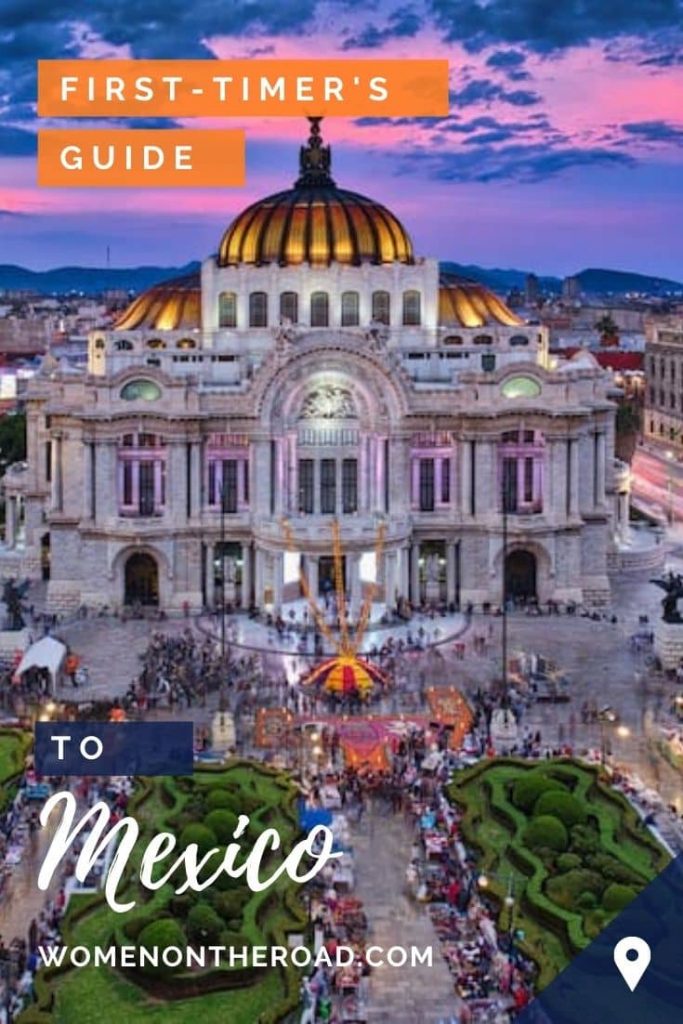Mexico is one of the most visited destinations in the world, in(famous) for spring breakers parties, massive all inclusive hotels, tacos and tequila. Well, perhaps also for its narco lords.
But Mexico is so much more than that! It is an astoundingly beautiful country with tremendous geographical diversity and countless natural treasures, a turquoise Caribbean coast, a beguiling cultural heritage, and an extraordinary culinary tradition.
What you may not know is that it is excellent for over 50 solo travel.
Also, there is so much to see this one post cannot cover it all.
I’ve been living and traveling throughout the country for seven years and this is now my home. What follows is a look at my personal take on the most interesting places to visit in Mexico.
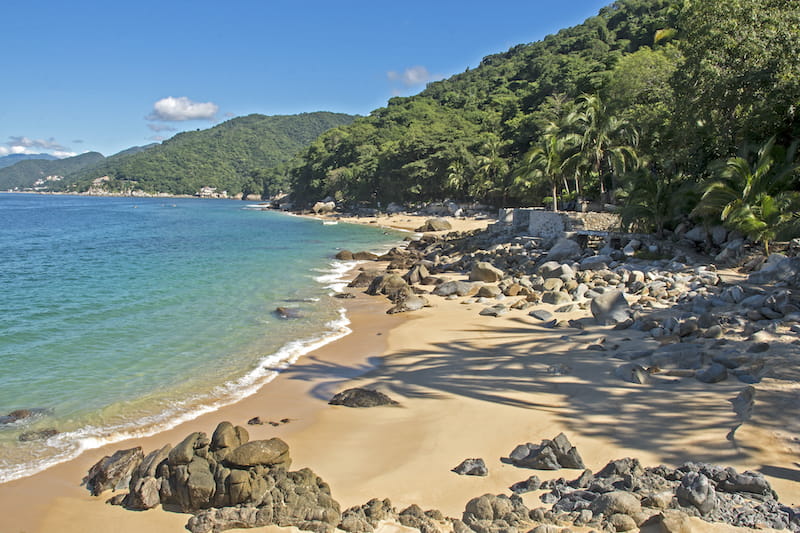
IS TRAVEL IN MEXICO SAFE?
Mexico travel safety has been the topic of much discussion. Women are often warned to stay away, especially if they’re traveling solo. Sadly, each time there is a crime or gang war, news channels play them up as though that were the only side to that story.
The reality is very different: solo women CAN travel safely and easily in Mexico. Let me explain how.
As mentioned, I have lived here for years and traveled alone around Mexico extensively by bus and car.
I loved every bit of it, and enjoyed exploring less traveled roads, discovering spectacular hidden waterfalls, getting to know the culture and trying local specialties. Of course, knowing the language helps, as does understanding the country’s diversity. Every state has its own identity, cultural traditions and typical dishes, not to mention its own safety profile.
This said, I have never felt in danger in my travels. But then, I have also been cautious.
Mostly, the dangers you’ll face will be related to petty theft and assaults, which tend to occur in specific situations and isolated areas you should, in any case, avoid.
Like everywhere, Mexico requires following a few common sense rules. Like these.
- Be friendly, but not naive. Talk to people and smile, but set your boundaries and if things get uncomfortable, feel free to move away. Trust your gut feelings. If something feels wrong, it is.
- A little Spanish goes a long way. Locals will love to talk to you in English, either because they want to practice or show off (in a good way). But it’s also kindness and courtesy on our part to show we are making an effort to learn the language. (Here’s how to learn a bit of the language if you don’t speak a word.)
- Don’t flaunt your wealth. Try to avoid waving around your flashy camera or jewelry or brand new iPhone. Temptation is temptation.
- If you are on a long journey, don’t mention it. Locals may not understand that we can travel on a budget and may think you are wealthy. This is not the kind of popularity you need.
- Do not walk alone in dark isolated roads or parks. But you wouldn’t do this anywhere, would you?
- Keep some cash on you, in a safe place. A money belt will do the trick.
- Still concerned about safety? Here are some general solo female travel tips you can use to stay safe in Mexico and anywhere else you travel.
BEST PLACES TO TRAVEL TO IN MEXICO
The map below will give you an idea of where Mexico’s states are located − and will also provide you with a sense of just how large the country actually is: almost three times the size of Texas.
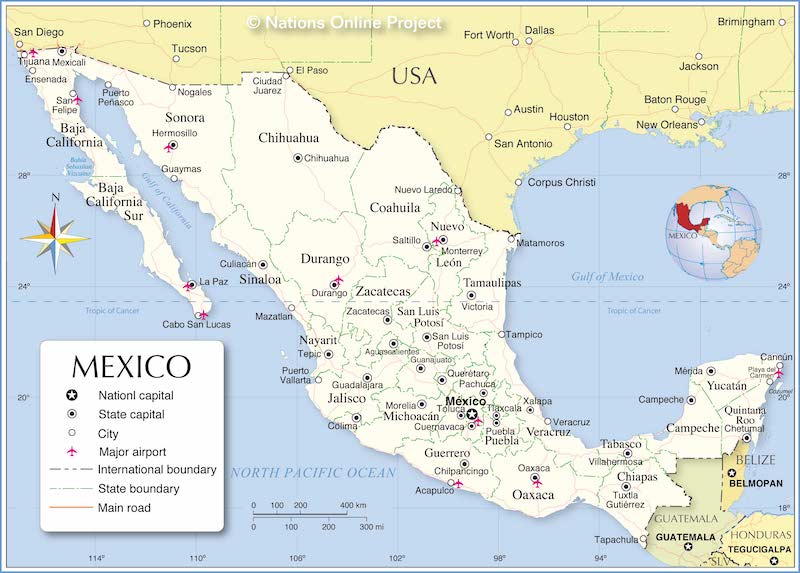
And now, let’s look at some of the outstanding Mexico travel places you simply cannot miss on your trip.
THE YUCATAN PENINSULA
The Yucatan Peninsula is probably the most visited and talked about region of Mexico, a vast and diverse territory with many things to do and places to explore.
This is the land of Caribbean white sand beaches and turquoise seas, glorious archeological sites, custodians of the Mayan heritage, and refreshing cenotes, sacred lakes for the ancient Mayan civilization and now a delight for tourists.
The Yucatan Peninsula includes three states:
- Yucatan, the safest among the Mexican states
- Campeche, home of the spectacular Calakmul biosphere and Mayan site
- Quintana Roo, the all-time favorite and home of the Riviera Maya (the Mexican Caribbean coast that stretches from Puerto Morelos to Tulum in Quintana Roo State), Cancun and boho-chic, overpriced Tulum
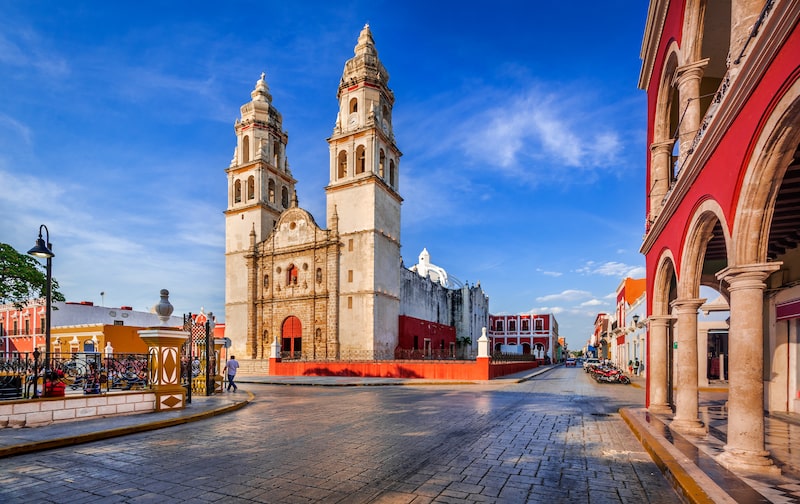

The best way to enjoy this region is by renting a car and driving around, so that you can reach those amazing off-the-beaten-path spots where local transportation won’t take you. Driving in this part of Mexico is relatively safe.
Using local transportation is also possible in the Yucatan Peninsula. It may not be as practical as having your own car, but public transport is quite well organized and both buses and colectivos, or minivans, will take you almost anywhere.
A final option is to park yourself in one of the amazing beach hotels and either take daily tours to each individual destination or take a day tour to some of the Yucatan’s attractions.
BAJA CALIFORNIA
If you love sea life, dramatic landscapes and wine, Baja California may be your Mexico travel destination of choice.
Stretching into the Pacific Ocean for more than 1000km/600mi, the Baja peninsula includes the Mexican states of Baja California, bordering the US in the north, and Baja California Sur, which ends in the Pacific Ocean, with its rough coastline and famous arch of Cabo San Lucas.

The Sea of Cortez, enclosed between Baja and the Mexican mainland, is home to such a wealth of sea life that Jacques Cousteau named it the world’s aquarium.
The best time to visit Baja California Sur is winter, from January to March, not only for its mild temperatures, but especially because it’s whale-watching season.
Different whale species migrate from Alaska and can be spotted all along the coast.
From Cabo San Lucas, you might see humpback whales; from San Ignacio and Lopez Mateos, friendly grey whales are visible; from Loreto, the sight of the gigantic blue whales will leave you speechless. (In summer, you can still spot whales: head for the Caribbean coast, to Cancun, Isla Mujeres or Holbox, for sightings of whale sharks.)
La Paz is also home to one of the best beaches in Mexico, Playa Balandra. Stroll along the city’s malecón, or promenade, and enjoy the spectacular sunsets.
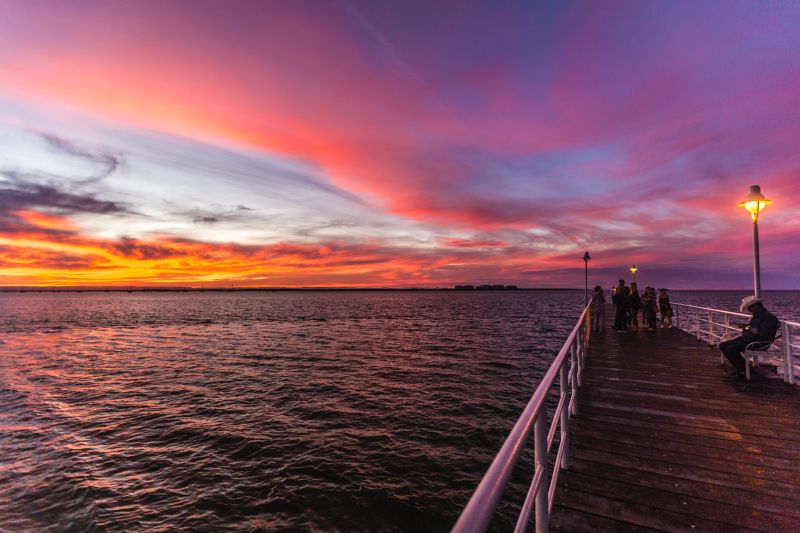
Driving solo around Baja California is quite safe – but it’s also the only way to explore. Public transportation here is far less efficient than in the Yucatan. You can always take a tour, but having your own car means you’ll be able to reach amazing spots the tours don’t visit.
Here are just a few of the activities you could enjoy in Baja California:
- Wine Tasting in Ensenada
- Bird-watching in Cabo Pulmo and Los Cabos
- Hiking in the Sierra de la Laguna between Los Cabos and La Paz and in the Sierra de las Gigantas
- The spectacular rocky backdrop of the Bahia of Loreto.
CHIAPAS
Close to the Guatemalan border, Chiapas is one of the cultural capitals of Mexico, its dense forests filled with Mayan ruins and historical villages.
Historically, Chiapas is known for the Zapatista movement, which started during the Mexican Revolution in 1910 and continues to this day. Led by Emiliano Zapata, poor farmers and other marginalized groups rebelled against the government and large land tenants. They took their name − Zapatistas − from their leader and in 1994, a new uprising garnered international attention. Since then, there have been uneasy peace efforts, occasionally interrupted by low-level violence but tourists have been largely unaffected.

Its capital, San Cristobal de las Casas, is a lovely colonial town with colorful houses, surrounded by lush green mountains. This is a favorite of digital nomads and expatriates, who enjoy its laid-back lifestyle and friendly atmosphere.
Browse around the lively market, full of bright, locally handmade textiles. Sit in one of the artfully decorated cafés, and when you’ve had enough, take one of the local tours to explore the spectacular natural treasures of this region.
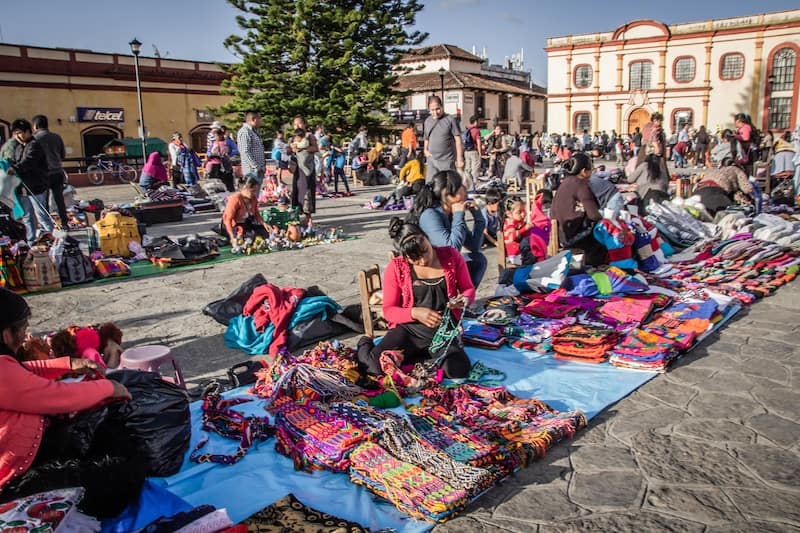
Chiapas may be one of Mexico’s poorest states, yet it is also one of the most beautiful, and rich in natural resources. You’ll want to visit the Lagunas de Montebello, Cañon del Sumidero (which you can always do with a tour) and its spectacular views from the lookouts, the lavish waterfalls of Agua Azul and El Chiflón, and the majestic archeological site of Palenque, one of the most important Mayan sites.
To get away from the tourist crowds, head for some of the lesser known and underrated (yet spectacular) archeological sites of Yaxchilan and Bonampack, near the Guatemalan border. From there, you could cross the Usumacinta River and into Guatemala.

OAXACA AND HIERVE EL AGUA

The beaches of the Mexican Pacific coast are not as swimmable as those on the Caribbean side, because the currents are strong and waves are mainly suitable for surfers. But the views they offer are the most spectacular and worth the trip.
If you’d like to watch surfers riding the waves, head for the world-famous Zicatela Beach in Puerto Escondido, home to one of the world’s most popular surfing competitions. But remember not to miss Mazunte, San Agustinillo and Zipolite, with their spectacular rugged coast, embraced by the lush mountain range of the Sierra Madre.
As for the city of Oaxaca, it is one of the most beautiful in Mexico. Its cobblestone streets, art galleries, colorful historical buildings and the delicious traditional food will win you over. So will its surrounding treasures.


Make sure you pay a visit to Monte Alban and Mitla archeological sites, and don’t miss the petrified waterfalls of Hierve el Agua, a breathtaking natural wonder.
INSIDER TIP: To enjoy Hierve el Agua without the tourists, rent a car or use public transportation and go on your own early in the morning, before the tourist busses arrive. It’s the only way to experience the magic of this place.

QUERETARO AND THE SIERRA GORDA
Queretaro is less touristy than many other cities, and if you love colonial architecture and art, you’ll think its historical center is an open air museum. The city also brims with world-class restaurants, and is surprisingly sensitive to plant-based eaters.

But Queretaro is not only about the city. This tiny state boasts a huge number of hidden corners, such as the “Pueblo Mágico” of Tequisquiapan and its vineyards, the giant monolith of Bernal, and the spectacular Sierra Gorda, with its hidden waterfalls, canyons and ancient monasteries.
From Pinal de Amoles, a pretty town in the Sierra Gorda, you can take a bus to Xilitla, the popular town which is home to the mystical Edward James enchanted garden. You can then move on to the Huasteca Potosina, known for its impressive natural system of waterfalls, rivers and caves.


PUEBLOS MAGICOS
The Mexican government has proclaimed 132 Pueblos Mágicos. These are towns with particular charm, historically important or close to natural attractions. They are all attractive destinations and well worth the visit if you are near them. Some of the most popular include Bacalar, Tulum, Valle de Bravo, Tepoztlan, and Taxco.
GUANAJUATO AND SAN MIGUEL DE ALLENDE
A highlight of any trip to Mexico are the colonial cities of Guanajuato and San Miguel de Allende, both located in the Guanajuato State, an hour’s bus ride from one another.
San Miguel de Allende
San Miguel de Allende has been proclaimed one of the most beautiful cities in the world, replete with cobblestones, cafés, restored architecture and plenty of art galleries.
Many complain that the city has lost some of its Mexican character, given the number of retired expatriates who call it home. But who can blame them? San Miguel’s unparalleled beauty has this effect on you. You go for a visit and may never want to leave. Keep this in mind when you visit. You have been warned!

Guanajuato
Guanajuato is home to the one of the most prestigious universities in Mexico, so it naturally attracts students, which makes it both lively and a colonial town full of traditions and culture.
If you understand a little Spanish, do not miss the Callejoneada, a night show offered by students for a small fee. It’s cheap and entertaining: students will guide you around the most iconic spots of the city, cracking jokes and sharing legends and historical anecdotes, a great way to learn about local history.
Guanajuato is also known for the Festival Cervantino, a cultural event that takes place every year in October to celebrate culture and art.
NOTE: Lately, the State of Guanajuato has been declared one of the most dangerous regions in Mexico because of ongoing fights between drug lords. That is undeniably true, but much of the violence is localized and gang related, and unless you find yourself in the middle of one of these conflicts, they should not affect you. But it’s better to be forewarned.



COPPER CANYON
If you want the experience of a lifetime, then you’ll visit Copper Canyon, locally known as Barranca del Cobre.
Did you know that it is bigger than the Grand Canyon? (It is, but only if you group all six separate canyons in the Copper Canyon system.)
The canyon is in the heart of Chihuahua State, (yes, where the little dog breed comes from), which is also considered a hot zone for drug lords. But again, the area is largely safe and I have never felt in danger. When in doubt, ask locals about any possible danger zone.

The highlight here is El Chepe, the only passenger train in Mexico. Ride El Chepe along the Copper Canyon ridge for spectacular views. And for breathtaking sunsets, stop along the way and stay in one of the hotels facing the canyon. Brace yourself for breathtaking sunsets.
The train runs from Los Mochis to the city of Chihuahua and the best stops are El Divisadero, Posada Barranca and Creel, a lovely pueblo mágico where you can stay for a week and enjoy daily tours. Local transportation is not really reliable here and you might find yourself stranded if the bus doesn’t show up, so best take one of the day tours to get around.
A great time to visit is from April through October, but not only. Easter week (Semana Santa) is crowded and a little more expensive but you can participate in a Tarahumara community Easter celebration and witness the syncretism between a Catholic mass and indigenous tradition.
In winter, you will be able to enjoy the Copper Canyon covered with snow, which also could be fascinating, but cold!
PUEBLA
Puebla is the food capital of Mexico.
With no offence meant towards other regions, Puebla really beats them all in terms of variety of food, traditions, and creativity.
From cemitas, the giant, richer version of an American burger, to the unique chile en nogada and the Puebla sweets, there are endless culinary options here.
An entire street of Puebla’s historical center – Calle de los Dulces – is dedicated only to sweets! There are hundreds of varieties of all shapes and colors, each with its fancy creative name.
But Puebla is not only about food. It has unique Baroque architecture, for which it is listed as a UNESCO World heritage site, along with a dedicated Baroque museum in celebration of Puebla’s cultural heritage.
As for safety, feel free to wander around on your own, but in daylight, not after dark on isolated roads.

THE RIVIERA NAYARIT
The Riviera Nayarit is a wonderful alternative (and an eminent competitor) to the Riviera Maya.
While the young outdoor crowd will head for Sayulita’s surf spots and vibrant nightlife, there’s plenty here for the rest of us: getting pampered in luxury hotels, basking on secluded beaches, sampling delicious cuisine, experiencing yoga retreats or discovering local arts.
The Riviera Nayarit has plenty of destinations you can head for: the world renowned resort of Puerto Vallarta, with its amazing street food, art galleries, colorful markets and fancy restaurants (and beaches, of course!), or the relaxing paradise of San Pancho.
MEXICO CITY
Last but not least… no guide to Mexico would be complete without a quick mention of its spectacular capital city, although it would require an entire book to do it justice.
Often considered chaotic and dangerous (which is not inaccurate), you’ll enhance your safety by following some sensible rules: don’t go out alone at night, avoid narrow isolated streets, don’t be unreasonably friendly, and use Uber to get around.
That said, the capital is a must-see when you visit Mexico, filled as it is with history and culture.
Here are just a few Mexico City attractions to explore: the Archeological Museum, Chapultepec Park, the Palacio de Bellas Artes cultural center, Frida Kahlo’s museum home in Coyoacán, a stroll around the high-end neighborhoods of La Condesa or Roma.

MEXICAN FOOD
We all associate Mexican food with guacamole, tacos and tequila. But although they may be common all around Mexico, each state has its own unique specialties that make its people so very proud. Here some must-eat Mexican dishes that you cannot miss. (Well, except for one, perhaps…)
Tlayuda
Typical of Oaxaca, this is a large, semi-dried tortilla, topped with refried beans (frijoles), tomato slices, avocado, and some variation of meat. It can either be served open, or when it’s cooked on a charcoal grill, folded in half. You can also get a vegan or vegetarian version, as those of us travelers who don’t love meat become increasingly common.
Mole
Mole is a spicy dark chocolate sauce whose hues change depending on the spice. The original mole comes from Puebla, but Oaxaca Mole is also quite popular. Mole is used as a sauce for different meat cuts, especially chicken. If you are not a meat eater, you can also try it with bread, although that kind of defeats the purpose.
Chile en Nogada
Chile en nogada is one of the most popular dishes from Puebla but is also considered one of the national dishes because of its colors, which are those of the Mexican flag, and because it is usually eaten only around Independence Day celebrations. It is made of with chiles from Puebla, and a mixture of meat and dried fruit. It is also a seasonal dish so if you would like to try it, make sure to be in Puebla between the end of July and October.

Molletes
You can find these almost everywhere in Mexico but I especially ate them in Queretaro and Puebla. This is usually a breakfast dish, and vegetarian, with a vegan version available. A bolillo (a type of bread) is cut in half and toasted, then topped with refried beans, pico de gallo (finely chopped tomatoes, onion and fresh coriander or cilantro) and melted cheese.
Chapulines
Ah! These are for adventurous foodies only. Fried crickets, if you dare. (And no, I haven’t tried them! My excuse? I’m vegetarian.)
Typically sold in Oaxaca, you can also find them in Mexico City and Puebla, especially in markets.
Obviously, this list of delicious Mexican dishes is far from complete and I just wanted to mention the most popular. It will be up to you to discover the other local delicacies when you reach your Mexican destination. Ask your host or check out a local street food stand or a market and enquire about their typical dish. It’s a great way to practice your Spanish and mingle with locals, who will be delighted to show off their specialties.
How to ask for food in Spanish
- ¿Cuál es el plato típico de acá? What is the typical dish here?
- ¿Que lleva? What are the ingredients?
- ¿Me daría uno por favor? Can I have one, please?
- ¿Cuanto cuesta? How much is it?
- La cuenta por favor. The bill please
- Una persona por favor. A table for one, please.
Markets and street food in Mexico
All the main cities and towns have their own markets. The bigger is the city, the bigger the market. Get ready for a multisensory experience of colors, scents and flavors.
Most markets have food courts where you can try local delicacies, and here are my favorites:
- Coyoacan Market in Mexico City
- The general market in Valle the Bravo where I had the most delicious vegan meal
- Tepoztlan pueblo magico
- Nicolas Bravo Market in La Paz, Baja California
You may not feel like eating in every market: some can be less appealing, but that depends on how picky you are. While they tend to be safe, make sure you keep your belongings well protected and stay on the alert about your surroundings, standard advice for markets around the world.
Also, make sure you listen to your gut feelings. In Guadalajara’s famous Mercado Libertad San Juan de Dios, I just had to run away. It was so crowded and packed I just didn’t feel safe at all and left, with no regrets.
Another great way to eat is by sampling street food, which is very typical of Mexico and is sometimes the most delicious.
The best tacos are eaten on the road, but these are definitely not for vegetarians or vegans. Nor are all food stalls hygienic and tasty. Ask around for the best street stalls or look for a busy place. If people are waiting in line for food, this is normally a good sign.
As for the cups of fruit chunks sold on the street, they may look very inviting, but I would ask the vendor to prepare one on the spot to make sure it hasn’t been exposed or touched.
WHERE TO STAY IN MEXICO
Mexico’s accommodation options are endless and diverse and will satisfy any budget and taste, from a five-dollar bed to a US$ 1,000-a-night suite and everything in between.
Staying in apartments or villas, especially for longer periods, has become quite popular and Airbnb in Mexico is considered quite safe (coming from someone who has been living in Airbnb for the past three years).
Style-conscious travelers will find spectacular boutique hotels and design properties in colonial cities such as Queretaro or San Miguel de Allende.
But the most exclusive and original of all, if you are ready to splurge, are the Yucatan Haciendas, old plantation mansions that have been renovated and turned into spectacular luxury hotels, where modern and comfort merges with that vintage feel and world class decor.
MY HACIENDA PICKS
I’ve stayed at the Hacienda Temozon, which is absolutely spectacular, just like the others of the Marriott Luxury Collection: Hacienda Uayamon, Hacienda Puerta Campeche and Hacienda San José. Another spectacular establishment is the relatively new Chablé Resort and Spa. Hacienda Sac Chic, close to the cenote villages of Homun and Cuzamá, is another gem that harmoniously combines the old and the new. Even if you’re not ready to blow your budget, you can always ask for a visit. In fact, one particular hacienda, Sotuta de Peon, organizes regular daily tours to show you around and explain the story behind the place (book in advance).
HOW TO GET AROUND MEXICO
Your itinerary and the time you have available will determine how you travel around Mexico, which you can do in a variety of ways.
Traveling around Mexico by bus
Bus travel in Mexico is perfectly feasible, if you have the time or if you are exploring a small area. Keep in mind that Mexico is huge.
For example, a trip from Cancun to Mexico City by bus takes about 25 hours, and Cancun to San Cristobal de las Casas 22 hours. If you do have time, then this is a comfortable and cheap way to travel.
When you travel by bus, remember to keep your personal belongings with you, either by wearing them or by keeping your bag on your lap. Never leave anything valuable in the overhead compartment.
Mexico’s main bus company is ADO, which runs mostly in the south with some routes in central Mexico. ETN is best for Mexico City and surroundings: these are luxury buses with TV screens and headphones.
Regions tend to have their own companies but not all of them are luxury buses. At the bus station, different companies often ply the same routes and usually (though not always), the more expensive the trip, the more reliable and nicer the buses.
(You can find a full rundown of Mexican bus travel here.)
Traveling solo around Mexico by car
You can travel around by car without problems but some areas should be avoided, especially at night.
Tabasco is not considered very safe, but if you travel on the main roads during the day you’ll be fine. The Yucatan Peninsula, on the other hand, is safe anywhere you go. Oaxaca state is safe, but it has winding mountain roads that require careful driving.
The best option for driving is to rent locally in a specific region. Mexico Car Rental has an excellent reputation for both price and reliability. Whatever you do, always buy the full insurance to avoid any inconveniences. There is also a facebook group called on the road in Mexico, where you can get real-time information on a specific itinerary.
Another option is Bla Bla Car, an online platform that helps you find rides if someone is driving where you’re going. You negotiate your rate and check each other’s reviews, but make sure your potential ride has quite a few positive reviews before you get into a car with a stranger.
Traveling around Mexico by plane
At the time of writing, flying around Mexico is being limited by the number of airline companies that remain, several teetering on the edge of bankruptcy due to the Covid epidemic. Aeromexico remains the most reliable and stable but you will have to check whether it and the low-cost airlines are still operating.
A FEW THINGS TO KNOW BEFORE TRAVELING TO MEXICO
These practical Mexico travel tips will be useful to know before traveling:
- Tap water is not drinkable, almost anywhere.
- Toilet paper can’t be flushed. Use the designated bin. It may sound gross, but that’s what it is. The official explanation is that pipes are small and get clogged easily.
- Learning a few words in Mexican-Spanish will save you time. “Ahorita”, for example, means an indefinite time between right now and never.
- Bring an adaptor. There are two types of sockets in Mexico: one with flat parallel pins and one with two flat parallel pins and a grounding pin. You will find adaptors in Mexico but you don’t want to waste your precious time looking for one.
- Be patient − the sense of time in Mexico is very personal.
- The best time to travel to Mexico depends on where you are going. Do not assume it’s hot everywhere in Mexico. In Chihuahua, it snows in winter; in Baja California, the sea is freezing cold in February; in San Miguel the Allende in January, temperature can get close to 0℃/32℉.
- Wifi works well most of the time.
- Museums are usually closed on Mondays.
- The Yucatan Peninsula is flat. If you want a hike with a view, head for the Pacific Coast or the central areas.
- Make sure you have health and travel insurance to travel to Mexico, especially as you may be visiting less frequented areas.
I hope this brief guide helps you plan your next trip to Mexico but most of all, I hope it shows how easy it is to travel around Mexico on your own. With a bit of caution and a slight sense of adventure, you will have an unforgettable trip.
Guest Contribution by Isabella Biava. Isabella is a restless traveler who has lived in Mexico for the past 11 years. She is now a nomad and on a quest to explore the world. She blogs at Boundless Roads and you can follow her Instagram accounts @Boundlessroads and @lets.travel.to.mexico
SHOP THIS POST ON AMAZON
PIN THESE PICTURES AND SAVE FOR LATER!
